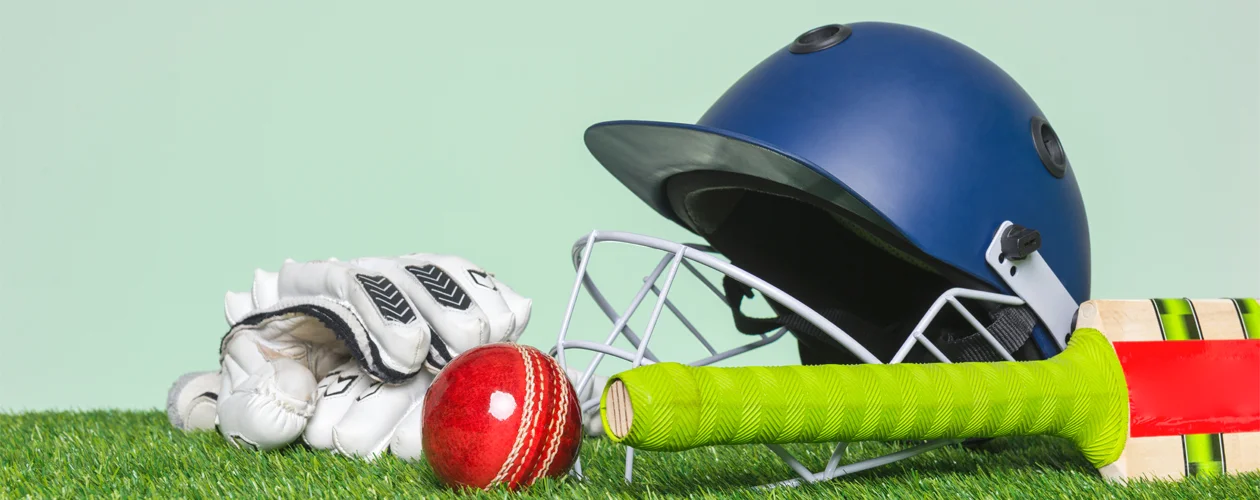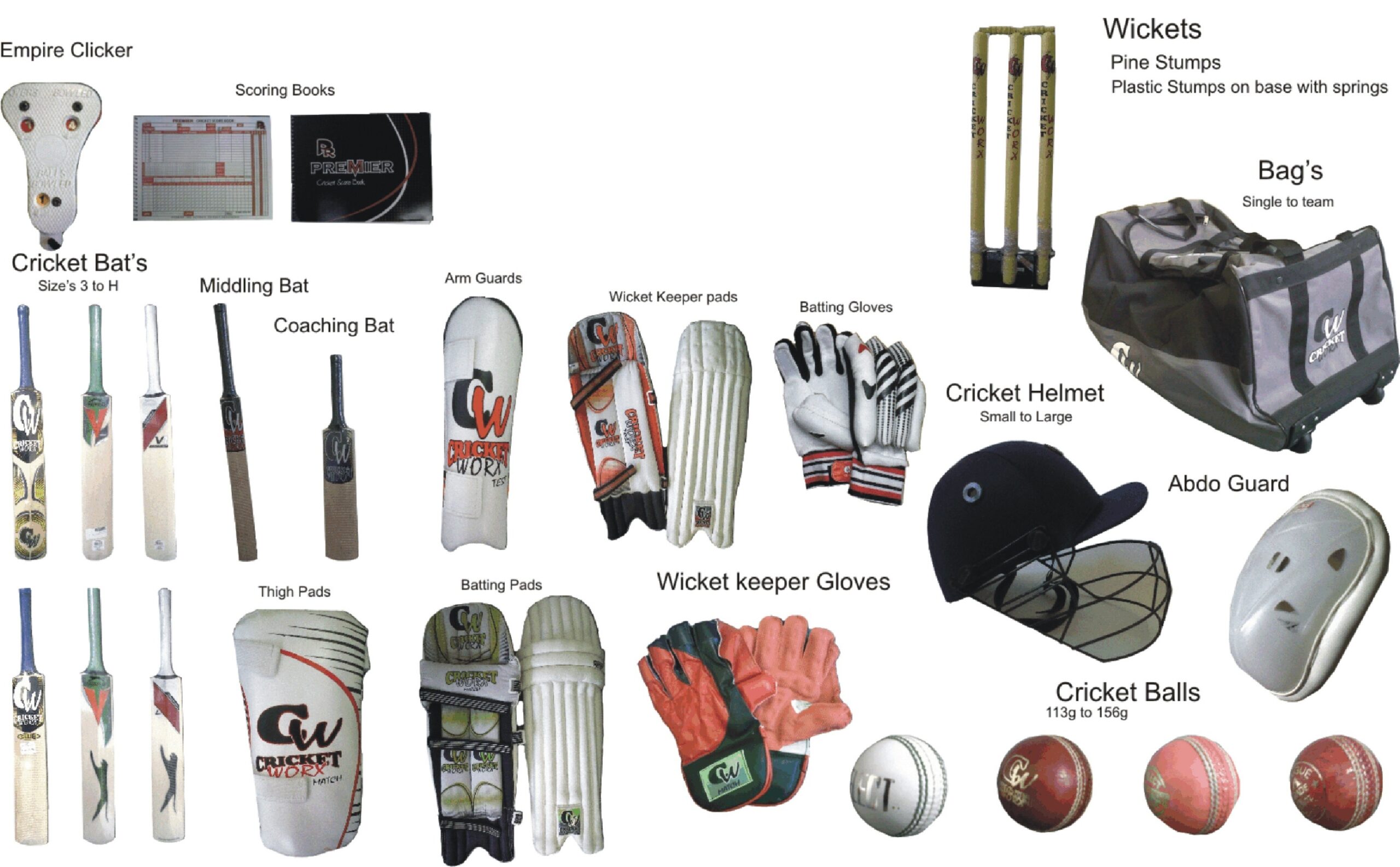Cricket Player’s Gear and Equipment
In India, where millions of people play and watch it, cricket is a well-liked sport. Players must be fully equipped in order to play safely and effectively because the game necessitates a special set of abilities and tools. The gear and accessories used by Indian cricket players, such as bats, balls, gloves, pads, helmets, chest protectors, arm guards, and shoes, will be covered in more detail in this post. We will discuss the purpose, history, and evolution of each piece of equipment. Whether a player or a fan, everyone who wants to understand cricket must have a thorough understanding of the gear and equipment used by players.

Cricket Bats
One of the most crucial pieces of gear required for the game of cricket is the cricket bat. A bat is an essential piece of equipment in the game because it is used to hit the ball and score runs. Cricket is an integral part of Indian culture, so cricket bats are a necessary piece of equipment for players of all ages and skill levels.
A cricket bat’s components include the blade, handle, grip, and toe. The bat’s main blade, which is the main part of the bat, is typically made of wood. Willow, which is both strong and light, is the most common type of wood used to make cricket bats. The blade’s thickness varies according to the player’s preferences. side and slightly curved on the other.
When batting, the cricketer holds onto the handle of the bat. Typically constructed of rubber or cane, it is fastened to the blade with.The handle and blade of the bat are joined by a tiny piece of wood called a splice. This solid connection allows the bat to withstand the force of impact when striking the ball.

Cricket Balls
The ball is one of the most important pieces of equipment in a game of cricket. The bowler uses the ball to throw the bat to the batsman in an effort to hit the wicket and remove him from the game. In this article, we’ll examine the specifics of cricket balls and how they apply to the game.
Cork and leather are used to make cricket balls. Before being wrapped in leather, the string used to wrap the cork ball is Regulations set forth by the ICC govern the size and weight of the cricket ball. The ball must weigh between 5.5 and 5.75 ounces and have a circumference between 8.81 and 9 inches in accordance with ICC regulations.
The durability of cricket balls is another essential characteristic. Depending on the circumstances and how much it is used, a cricket ball can last for up to 80 overs. The condition of the ball is crucial to the game and can be altered if it is lost or damaged. In Test cricket, the ball is changed every 80 overs, whereas in limited-overs cricket, the ball is changed after a set number of overs.
Batting Pads
Cricket batsmen must have batting pads, also referred to as leg guards, as part of their equipment. To shield the lower legs from injury from cricket balls, they are worn. Cricket batting pads are made by Indian companies and come in a variety of hues, designs, and sizes.
Batting pads’ main purpose is to shield the legs from the ball. They typically consist of three layers: a high-density foam outer layer, a softer foam middle layer, and a cotton or other breathable material inner layer. The inner layer offers comfort and breathability, while the outer layer is made to deflect the ball’s impact and distribute the force across the pad.
There are two primary types of batting pads: modern foam and traditional cane. Traditional cane pads are made of vertical cane strips that are joined together by a leather or nylon casing. Because of their durability and defense against quick bowling, some players favor them. On the other side, modern foam pads, which are made of lightweight foam materials, give the batsman additional flexibility and mobility.
Batting Gloves
Any batsman who plays cricket needs batting gloves as part of their equipment. They let you have a stronger grip on the bat, which increases confidence in your shots while also protecting your hands. This article will go into great length regarding the value and qualities of batting gloves in cricket.
Let’s now discuss the characteristics of batting gloves. Batting gloves come in a variety of designs, each with its own special qualities. These are some typical characteristics of batting gloves:
- Cushioning: The main purpose of batting gloves is to protect the hands. Good quality batting gloves have ample padding on the fingers, palm, and back of the hand, which helps absorb the impact of the ball.
- Grip: The grip of the batting gloves is crucial as it helps the batsman hold the bat firmly. A lot of batting gloves have extra padding on the palm, which makes it easier to grip the bat.
- Batting gloves have a tendency to perspire, so adequate ventilation is necessary to keep them from becoming slippery. The back of high-quality batting gloves usually has perforations or mesh, which promotes ventilation and keeps the hands dry.
- Flexibility: The gloves must be flexible and allow the batsman to freely move their fingers. Too much stiffness in the gloves can restrict the movement of the hands, making it difficult to grip the bat and make confident shots.
- Size: Batting gloves come in various sizes, and it’s essential to select the right size to ensure a comfortable fit. Gloves that are too tight can restrict blood flow to the fingers, while gloves that are too loose can slip off, making it difficult to grip the bat.
Wicket Keeping Gloves
Wicketkeeping is a key role in cricket, and wicketkeepers need particular equipment and instruments to do their tasks well. The wicketkeeping pads are one of the most important pieces of a wicketkeeper’s gear.
The primary function of the wicketkeeping pads is to shield the wicketkeeper’s legs from the impact of the cricket ball. The pads are also designed to be comfortable, light, and flexible to allow the wicketkeeper to move around easily.
To guard against impacts from the cricket ball, the front of the wicket keeping pads is typically covered with a strong, resilient material, like leather or synthetic material. To provide comfort and lower the risk of injury, the interior of the pads is typically made of a softer material, like cotton or foam.

Helmets
Although the game is thrilling and entertaining to watch, it can also be risky, particularly for the players who are receiving the ball. Helmets have become a crucial component of cricket players’ equipment in order to guarantee player safety, particularly with regard to head injuries.
All athletes in India are now required to wear helmets, especially batsmen and wicketkeepers. A helmet is a piece of protective gear worn over the head that softens the impact of the ball, especially when it is bowled quickly. For head protection, helmets include an internal lining of dense foam cushioning and an outside shell made of high-grade plastic or fiberglass.
Modern-day helmets are designed to provide maximum protection to the They are available in various sizes and shapes to comfortably fit the head. The majThe majority of helmets also feature a set of adjustable straps for a snug fit. it. The visor on the helmet protects the player’s face and eyes from the ball, and some helmets also come with additional features such as ventilation and sweat-absorbing pads.
Chest Guards
The chest guard is one of the most important pieces of equipment for a batsman. The hard ball, which can result in serious injury if struck with enough force, can cause serious injury if it hits the player’s chest and ribs without the chest guard.
High-density foam or plastic is typically used for the chest guard, which is intended to cushion the impact of the ball. It offers chest, rib, and abdomen protection when worn over a shirt. A chest guard is a crucial piece of gear for batsmen because it reduces the risk of injuries from balls hitting the chest or ribs.
The two major components of the chest guard are the shoulder straps and the chest pad. The chest pad, which covers the chest, is often constructed of high-density foam or plastic. Shoulder straps that pass over the shoulders and around the back are fastened to the chest pad to keep it in place. The straps can be altered for a comfortable and secure fit.
Arm Guards
While making shots, the batter must keep themselves safe. Arm guards are just as important for the batsman’s overall safety as helmets and chest guards. They are designed to absorb the impact of the ball and prevent injuries to the arm, elbow, and wrist.
The non-bowling arm is protected by arm pads or arm guards. High-density foam, which provides shock absorption and lessens the impact of the ball, is used in their construction. A hard outer shell made of plastic or fiberglass surrounds the foam, providing additional defense against fast bowlers.
To accommodate various arm sizes and preferences, arm guards are available in a variety of sizes and shapes. They are made to fit around the arm comfortably but snugly. They must be worn snugly, but not so snugly as to limit movement.
Forearm, elbow, and wrist guards are the three main components of an arm guard. The forearm is protected by the forearm guard, which is the largest component of the arm guard. The elbow guard shields the elbow joint from blows by covering it. The wrist guard shields the wrist and its surroundings from injury.
Shoes
One of the most important pieces of gear for any cricket player is a good pair of shoes. The right footwear can significantly impact a player’s performance, especially with regard to their balance and mobility on the field. The significance of shoes in cricket as well as the various types of cricket shoes available in India will be covered in this section.
Cricket players typically wear shoes with spikes on the bottom, which improves their grip on the field, especially on grassy surfaces. Spikes can be fixed or removable and are typically made of rubber or plastic.
Cricket players stand on their feet for long periods of time, and wearing uncomfortable shoes can cause fatigue. It’s crucial to pick footwear that fits comfortably and offers the player’s feet enough support. The insole and midsole of most cricket shoes are cushioned to absorb shock and lower the risk of injury. These shoes are typically made of leather or synthetic materials.
In India, there are several different varieties of cricket shoes, each with its own advantages and features. Let’s examine some of the most well-liked types:
- Cricket spiked shoes: As previously mentioned, cricket spiked shoes feature spikes on the sole to improve traction on the field. These shoes have replaceable spikes and are appropriate for playing on grassy surfaces.
- Cricket shoes with rubber soles offer an alternative to spiked footwear. They are suitable for playing on both grassy and hard surfaces and offer good traction on the field. Younger players frequently prefer rubber sole shoes over spiked shoes because they are typically lighter and more comfortable.
- Cricket all-rounder footwear: All-rounder footwear is made for players who bowl, field, and bat. These shoes have a combination of spikes and rubber studs on the sole, providing good grip on both grass and Additionally, all-rounder shoes typically last longer and provide better foot protection for athletes.
- Cricket shoes for indoor use: These shoes are made specifically for indoor cricket. To enable quick movements on the court, these shoes have a flat, non-marking sole and are made of lightweight materials.
